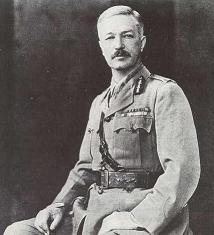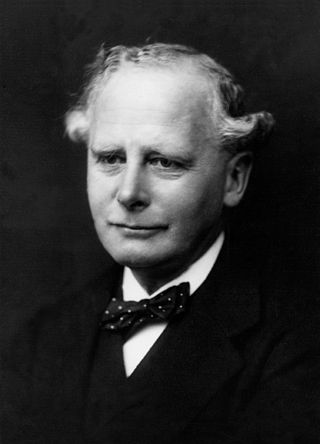
George Nathaniel Curzon, 1st Marquess Curzon of Kedleston,, styled The Honourable between 1858 and 1898, then known as TheLord Curzon of Kedleston between 1898 and 1911, and TheEarl Curzon of Kedleston between 1911 and 1921, was a prominent British statesman, Conservative politician and writer who served as Viceroy of India from 1899 to 1905.

Colonel Reginald Edward Harry Dyer, was an officer of the Bengal Army and later the newly constituted British Indian Army. His military career began in the regular British Army but he soon transferred to the presidency armies of India.

Sir Harold George Nicolson was a British politician, diplomat, historian, biographer, diarist, novelist, lecturer, journalist, broadcaster, and gardener. His wife was the writer Vita Sackville-West.

Field Marshal William Riddell Birdwood, 1st Baron Birdwood, was a British Army officer. He saw active service in the Second Boer War on the staff of Lord Kitchener. He saw action again in the First World War as commander of the Australian and New Zealand Army Corps during the Gallipoli Campaign in 1915, leading the landings on the peninsula and then the evacuation later in the year, before becoming commander-in-chief of the Fifth Army on the Western Front during the closing stages of the war. He went on to be general officer commanding the Northern Army in India in 1920 and Commander-in-Chief, India, in 1925.

Lawrence John Lumley Dundas, 2nd Marquess of Zetland,, styled Lord Dundas until 1892 and Earl of Ronaldshay between 1892 and 1929, was a British hereditary peer and Conservative politician. An expert on India, he served as Secretary of State for India in the late 1930s.
Indology, also known as South Asian studies, is the academic study of the history and cultures, languages, and literature of the Indian subcontinent, and as such is a subset of Asian studies.

Sir John Davidson Beazley, was a British classical archaeologist and art historian, known for his classification of Attic vases by artistic style. He was professor of classical archaeology and art at the University of Oxford from 1925 to 1956.

Lieutenant-General Sir Percy Henry Noel Lake, served as a senior commander in the British and Indian Armies, and in the Canadian Militia. He served during World War I.

Udham Singh was an Indian revolutionary belonging to Ghadar Party and HSRA, best known for assassinating Michael O'Dwyer, the former lieutenant governor of the Punjab in India, on 13 March 1940. The assassination was done in revenge for the Jallianwala Bagh massacre in Amritsar in 1919, for which O'Dwyer was responsible and of which Singh himself was a survivor. Singh was subsequently tried and convicted of murder and hanged in July 1940. While in custody, he used the name 'Ram Mohammad Singh Azad', which represents the three major religions in India and his anti-colonial sentiment.

Sir Walter Elliot, KCSI was a British civil servant in colonial India. He was also an eminent orientalist, linguist, archaeologist, naturalist and ethnologist who worked mainly in the Presidency of Madras. Born in Edinburgh, he studied at the East India Company College at Haileybury and joined the East India Company's civil service at Madras in 1820 and worked on until 1860. He was invested Knight Commander of the Order of the Star of India (KCSI) in 1866.

Sir Michael Francis O'Dwyer was an Irish colonial officer in the Indian Civil Service (ICS) and later the Lieutenant Governor of Punjab, British India, between 1913 and 1919.
Michael Sadleir, born Michael Thomas Harvey Sadler, was a British publisher, novelist, book collector, and bibliographer.

Sir Michael Ernest Sadler was an English historian, educationalist and university administrator. He worked at Victoria University of Manchester and was the vice-chancellor of the University of Leeds. He was also a champion of the English public school system.

The Jallianwala Bagh massacre, also known as the Amritsar massacre, took place on 13 April 1919. A large, peaceful crowd had gathered at the Jallianwala Bagh in Amritsar, Punjab, British India, during the annual Baishakhi fair to protest against the Rowlatt Act and the arrest of pro-independence activists Saifuddin Kitchlew and Satyapal. In response to the public gathering, the temporary brigadier general R. E. H. Dyer surrounded the people with his Gurkha and Sikh infantry regiments of the British Indian Army. The Jallianwala Bagh could only be exited on one side, as its other three sides were enclosed by buildings. After blocking the exit with his troops, Dyer ordered them to shoot at the crowd, continuing to fire even as the protestors tried to flee. The troops kept on firing until their ammunition was exhausted. Estimates of those killed vary from 379 to 1,500 or more people; over 1,200 others were injured, of whom 192 sustained serious injuries. Britain has never formally apologised for the massacre but expressed "deep regret" in 2019.

Charles Wallace Alexander Napier Cochrane-Baillie, 2nd Baron Lamington,, was a British politician and colonial administrator who served as Governor of Queensland from 1896 to 1901, and Governor of Bombay from 1903 to 1907.

Sir Wilhelm Philipp Daniel Schlich, also known as William Schlich, was a German-born forester who worked extensively in India for the British administration. As a professor at Cooper's Hill, he influenced colonial forestry across the British colonies. His major work was a five volume Manual of Forestry (1889-96).
Lieutenant-General Sir Henry D'Urban Keary was a British Indian Army officer, who served in a number of colonial conflicts before commanding an Indian division on the Western Front during the First World War.

Sir William Mitchell Acworth KCSI was a British railway economist, barrister and politician.
Sir Clarmont Percival Skrine (1888–1974) was a British civil servant and administrator who served as the British consul-general in Kashgar from 1922 to 1924, Under-Secretary of State for India and agent for the Madras States from 1936 to 1939.

The Patient Assassin, A True Tale of Massacre, Revenge and the Raj is a 2019 book based on the life of Indian revolutionary Udham Singh. Authored by Anita Anand, it was published by Simon & Schuster UK in April 2019 to coincide with the 100th anniversary of the Jallianwalla Bagh Massacre in Amritsar, India.
















